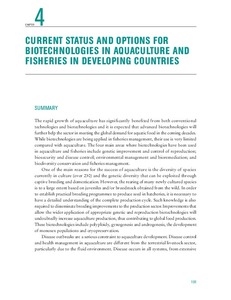| dc.date.accessioned | 2021-05-09T17:11:32Z | |
| dc.date.available | 2021-05-09T17:11:32Z | |
| dc.date.issued | 2011 | |
| dc.identifier.citation | Food and Agriculture Organization of the United Nations (FAO( (2011) Current Status and Options for
Biotechnologies in Aquaculture and Fisheries in Developing Countries. In: Biotechnologies for
Agricultural Development : Proceedings of the FAO International Technical Conference
on “Agricultural Biotechnologies in Developing Countries: Options and Opportunities in Crops, Forestry, Livestock, Fisheries and Agro-industry to Face the Challenges of Food Insecurity and Climate Change” (ABDC-10), Rome, Italy, Food and Agriculture Organization of the United Nations (FAO). pp.191-239. DOI: http://dx.doi.org/10.25607/OBP-1065 | en_US |
| dc.identifier.uri | http://hdl.handle.net/11329/1569 | |
| dc.identifier.uri | http://dx.doi.org/10.25607/OBP-1065 | |
| dc.description.abstract | The rapid growth of aquaculture has significantly benefited from both conventional
technologies and biotechnologies and it is expected that advanced biotechnologies will
further help the sector in meeting the global demand for aquatic food in the coming decades.
While biotechnologies are being applied in fisheries management, their use is very limited
compared with aquaculture. The four main areas where biotechnologies have been used
in aquaculture and fisheries include genetic improvement and control of reproduction;
biosecurity and disease control; environmental management and bioremediation; and
biodiversity conservation and fisheries management.
One of the main reasons for the success of aquaculture is the diversity of species
currently in culture (over 230) and the genetic diversity that can be exploited through
captive breeding and domestication. However, the rearing of many newly cultured species
is to a large extent based on juveniles and/or broodstock obtained from the wild. In order
to establish practical breeding programmes to produce seed in hatcheries, it is necessary to
have a detailed understanding of the complete production cycle. Such knowledge is also
required to disseminate breeding improvements to the production sector. Improvements that
allow the wider application of appropriate genetic and reproduction biotechnologies will
undoubtedly increase aquaculture production, thus contributing to global food production.
These biotechnologies include polyploidy, gynogenesis and androgenesis, the development
of monosex populations and cryopreservation.
Disease outbreaks are a serious constraint to aquaculture development. Disease control
and health management in aquaculture are different from the terrestrial livestock sector,
particularly due to the fluid environment. Disease occurs in all systems, from extensive
192 B iotech nolog i es for Ag r icu ltu ra l D eve lopm e nt SECTION 1: BACKGROUND TO
to intensive, and losses are possible in all types of production systems. There is a need
for better management of intensive systems, and biotechnologies are being used for this
purpose. Immunoassay and DNA-based diagnostic methods are currently used to screen
and/or confirm the diagnosis of many significant pathogens in aquaculture in developing
countries. Also, one of the most important factors leading to reduced antibiotic use
by the aquaculture sector is the availability of good prophylactic measures for diseases
causing severe mortalities in cultured fish and shellfish. The use of vaccines provides good
immunoprophylaxis for some of most important infectious diseases of finfish. As molecularbased vaccine production procedures rely heavily on biotechnological tools, vaccines are
being produced mainly in developed countries.
Reducing the environmental impacts of aquaculture is a significant task. Aquaculture
is often accused of being unsustainable and not environmentally friendly. Reducing the
impacts of effluent discharge, improving water quality and responsible use of water are key
areas to be considered in aquaculture development. Some biotechnologies are being used
to address these areas, including bioremediation for the degradation of hazardous wastes
and use of DNA-based methodologies for the early detection of toxin-producing algae.
In capture fisheries, the sustainable management and conservation of fisheries is a
priority. Better understanding of the population structure of the fishery is therefore of
paramount importance. Some biotechnologies have already been applied but there is ample
scope for the greater use of biotechnologies in fisheries management worldwide. The use of
molecular markers and the principles of population genetics have proved very effective for
assessing the actual levels of genetic variability within single populations and for measuring
the extent of differentiation between populations. | en_US |
| dc.language.iso | en | en_US |
| dc.publisher | Food and Agriculture Organization of the United Nations (FAO) | en_US |
| dc.subject.other | Aquaculture | en_US |
| dc.subject.other | Mariculture | en_US |
| dc.title | Current Status and Options for Biotechnologies in Aquaculture and Fisheries in Developing Countries. | en_US |
| dc.type | Report Section | en_US |
| dc.description.status | Published | en_US |
| dc.contributor.corpauthor | Food and Agriculture Organization of the United Nations (FAO) | en_US |
| dc.description.refereed | Refereed | en_US |
| dc.publisher.place | Rome, Italy | en_US |
| dc.format.pagerange | pp.191-239 | en_US |
| dc.subject.parameterDiscipline | Parameter Discipline::Fisheries and aquaculture | en_US |
| dc.description.currentstatus | Current | en_US |
| dc.title.parent | Biotechnologies for Agricultural Development: Proceedings of the FAO International Technical Conference on “Agricultural Biotechnologies in Developing Countries: Options and Opportunities in Crops, Forestry, Livestock, Fisheries and Agro-industry to Face the Challenges of Food Insecurity and Climate Change” (ABDC-10). | en_US |
| dc.description.sdg | 2 | en_US |
| dc.description.sdg | 14.7 | en_US |
| dc.description.bptype | Manual (incl. handbook, guide, cookbook etc) | en_US |
| obps.resourceurl.publisher | http://www.fao.org/3/i2300e/i2300e.pdf | en_US |
 Repository of community practices in Ocean Research, Applications and Data/Information Management
Repository of community practices in Ocean Research, Applications and Data/Information Management
